At Extraordinary Journeys, we like to push travelers just beyond their comfort zone—a place where (we believe) the real magic happens. We know game drives are one of the most exciting elements of a Tanzanian safari, but we wouldn’t be walking our talk if we didn’t encourage you to ditch the Land Cruiser at least once to experience the thrill of exploring the savannah on two feet.
What is a walking safari?
Walking safaris can be described as a guided hike through the bush. Led by a guide, a tracker, and possibly a local/Maasai guide, trails range from routes blazed by game or cattle herders to total wayfinding. Differentiated from bush walks—which tend to amble near camp and last about an hour—walking safaris are an extended jaunt through the wilderness. In their purest form, walking safaris return to camp each night—whether it’s a fly, mobile, or permanent installation.
What makes a walking safari special?
On foot, your senses sharpen. Immediately, your primordial instincts respond to the sights, sounds, and smell of the wilderness. Slowing down means the savannah’s supporting actors take center stage. Without a rumbling engine, you’ll notice laboring insects and delicate blooms while suddenly paying great mind to the direction of the wind.
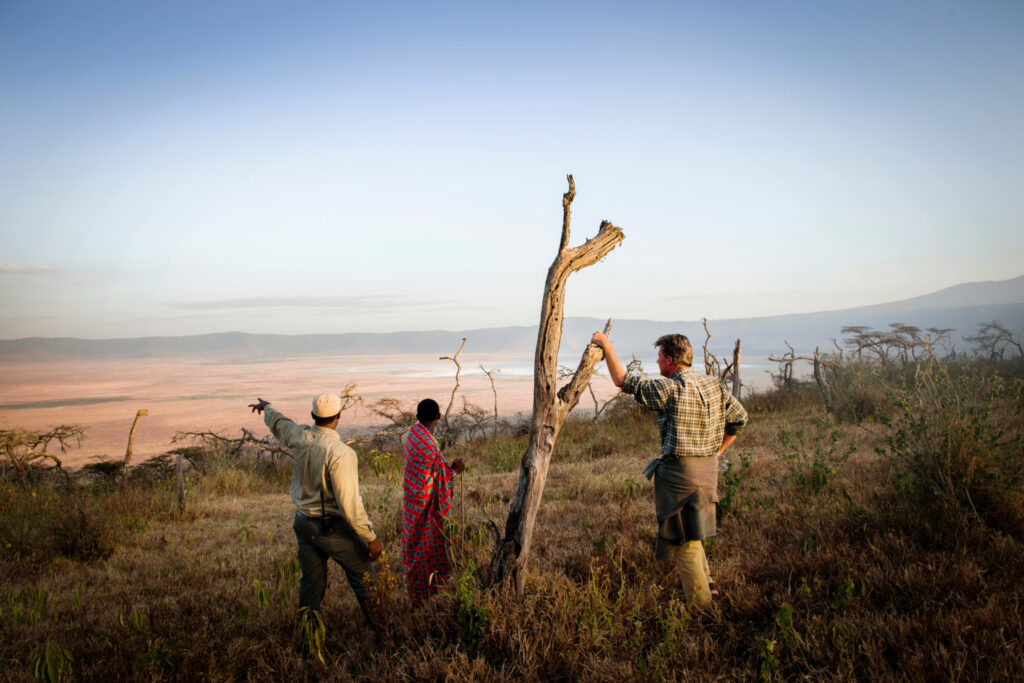
Who will enjoy a walking safari?
Walking safaris appeal to both seasoned safari-goers and first timers. What underwrites the experience for all is the opportunity to stretch your legs while taking a walk on the wild side. Traditional safari days revolve around twice-daily game viewing drives—which means you’ll log quite a few miles seated in a 4×4. The opportunity to (quite literally) get off the beaten path opens you up to unscripted moments in unspoiled nature. You’ll also appreciate the depth of knowledge your guide will impart, from plant and track identification to reading the signals of the bush.
For those who are wild at heart, embark on expedition-style walking safaris that last seven to ten days, threading together a diversity of landscapes. On these epics, you’ll hike nine to 15 miles each day, arriving at a fully assembled fly camp where comforts like warm bucket showers and hot meals greet you.
Are walking safaris strenuous?
Walking safaris are not highly technical and you won’t have to carry more than a day pack with drinking water. The terrain may be uneven and distances traveled may be moderate, but your guides will use any curiosity as an excuse to stop. You’re also likely to set out early in the morning, arriving at camp by noon to avoid the heat of the day.

Are African walking safaris safe?
It’s completely natural to raise an eyebrow at the idea of walking through big game territory outside of the safety of a vehicle. A walking safari is not without risk but with highly trained, expert guides, you’re in good hands. What’s more, someone in the party will be armed at all times. Pre-departure, guides will deliver a safety briefing. Following rules (like walking single file) and closely following guides’ instructions is paramount. Also, be mindful of the elements. Keep hydrated, protect yourself from the sun, and dress appropriately. Children are not permitted on walking safaris.
Guest safety is a value we share with our preferred partners, which is why we only work with the most reputable operators.
Wait, what is fly camping?
Despite what the name suggests, fly camping has nothing to do with flight. Rather, it’s a nod to the old school safari days when hunters took shelter beneath simple “flysheets”— lightweight covers that drape across a tent. Fly camp is a special experience offered at some safari camps, drawing guests out from luxurious canvas tents and into the bush for an unfettered night (or two) in the wilderness. You’ll walk to the fly camp in the company of a guide and a ranger to reach a fully assembled camp complete with your own minimalist, netted tent, a dining configuration, a long drop toilet and perhaps a warmed bucket shower. Sip a sundowner before tucking into a hot meal and then gather around the campfire beneath a starry sky. A ranger or warrior will keep watch for any wild things that go bump in the night.
Where are the best places to go on a walking safari in Tanzania?
From Mount Kilimanjaro and Ngorongoro Crater to the Serengeti and its Great Wildebeest Migration, northern Tanzania overdelivers on iconic East Africa experiences. Each attracts hundreds of thousands of visitors annually, sometimes reaching a fever pitch in peak season. But those who venture out on foot instead, just might experience these “wow” destinations in relative solitude. (Yes, even the Serengeti!)
Our favorite Tanzanian walks pass through The Great Rift Valley, Ngorongoro Conservation Area, Serengeti National Park, and we know of a gem down in Nyrere National Park, too. Read on…
BEST WALKING SAFARIS IN THE SERENGETI
Wayo Walking Safaris, Serengeti National Park

Normally, game viewing in Serengeti National Park means 4x4ing along well-worn, authorized tracks. On a private walking safari with Wayo Africa, you’ll hike from camp to camp through designated “wilderness” and “rhino protection zones”—vast, untouched tracts of the Serengeti few others are permitted to visit. There are no trails or commercial roads, nor permanent accommodations along this route. Each day, your lightweight eco-camp is packed and transported to the next scenic location. You’ll walk eight to 10 gentle miles with an experienced, knowledgeable guide and an armed ranger, bearing only the weight of your day pack. Any fascination, from paw prints to petals, is an excuse to stop. You’ll rendez vous later at a fully assembled camp—usually by noon—greeted with lunch and warmed shower water. Although your fly camp won’t serve crème brûlée in crystal dishes, delicious meals are served in three courses and you’ll slumber atop four-inch mattresses, hugged by pressed cotton linens. Creature comforts aside, a Wayo Walking Safari’s remote environs place you among the Serengeti’s generous populations of resident game not limited to lion, elephant, leopard, buffalo, giraffe, and zebra. During the Great Migration, camp locations become malleable, relocating to intersect with columns of wildebeest. All Wayo walking safaris are private, and tailor made. Trips can be long (~8 nights) or short, easy or challenging.
Fly Camping Adventure, Serian, Serengeti
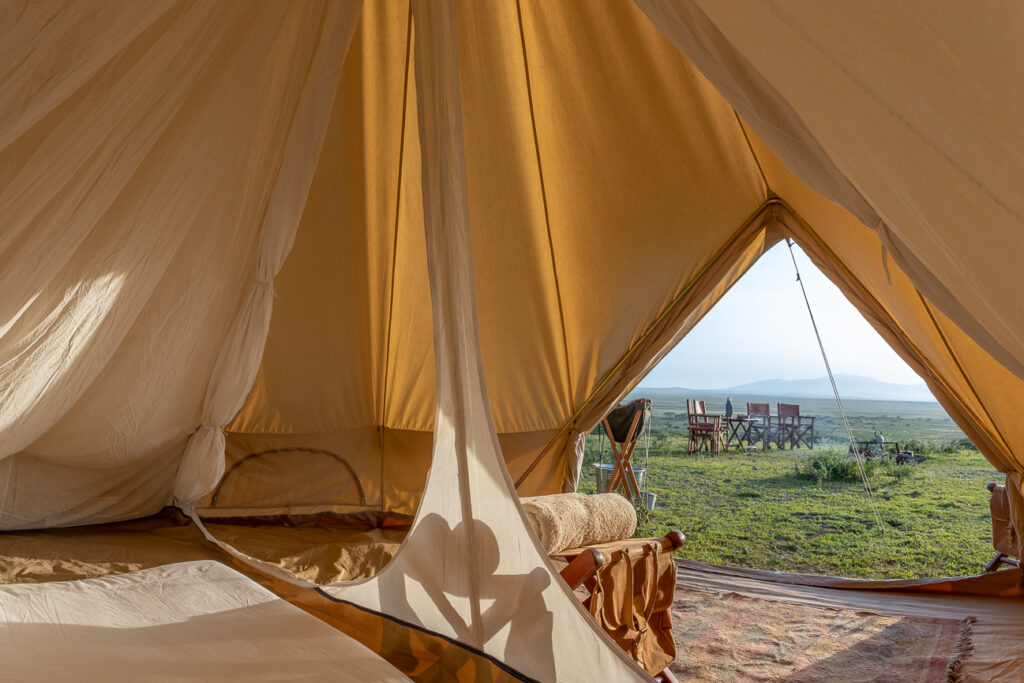
Incapable of ordinary, Serian’s fly camping/walking safaris elevate with whimsical canvas bell tents. The outfit’s week-long Soul Surfer and Soul Searcher itineraries bookend a handful of days spent fly camping with stays at their luxurious Serengeti North or Serengeti South mobile camps. Though the mobile camps are considered remote unto themselves, the fly sites lie well beyond any beaten track. You’ll have the wilderness to yourself, far from other vehicles and travelers. Absent the hum of an engine, you’ll appreciate the serenity that fills the Serengeti’s wide-open spaces. You’ll walk in lockstep with experienced specialist walking guides Alex, Chris, John or Adrian, and traditionally attired and armed Hadzabe guides whose families have lived on this land for centuries. Together, they will decipher what the environment seeks to conceal, hidden signs and their meanings. The walking safari is less about miles logged than your connection to the environment. At day’s end, when the sun makes its lazy arc toward the horizon, camp offers comforts like cozy beds, warm bucket showers and hearty meals served at the campfire beneath a star-studded sky. Serian fly camping experiences can be arranged as one-night or two-night/three-day adventures.
BEST WALKING SAFARIS NEAR THE NGORONGORO CRATER
A popular stopover on the Northern Circuit, Ngorongoro Crater is an undeniable natural wonder. Some 25,000 animals are cradled within the collapsed caldera, trapped by steep walls reaching 2,000 feet down to the crater floor. Unfortunately, Ngorongoro’s fish bowl phenomenon extends to both wildlife and tourists. During peak and high seasons, multiple vehicles bear down on wildlife, especially when predators are sighted—not exactly EJ’s preferred viewing experience. Luckily, we know of a few standout walks that will widen your perspective, far from the crowds.
Entamanu Ngorongoro

We love to send travelers to Entamanu Ngorongoro, an eco-lodge perched near the northwest rim in Maasai territory. This seven-room camp offers panoramic crater views from its front-looking decks and Serengeti plains at the back. (Guests also benefit from a private access road that bypasses the long queues that form at the main gates.)
From camp, set out on foot along ancient cattle trails where you may chance upon some Maasai neighbors herding livestock before reaching the Crater Rim Viewpoint (2-3 hours; 1.8 – 2.4 miles; seasonally from July through March.) This spellbinding vantage point offers jaw dropping crater-wide views. Be sure to train your binoculars downward for some high-point wildlife viewing. For a longer jaunt, the Crater Rim Walk stretches 3.7 to five miles. It can be done as a day hike or as your arrival—starting out near Seneto for a long, but magical walk into camp where the team will be waiting to welcome you.
For a culturally immersed highland amble, set off on a Maasai Boma Walk. On this two- to three-hour excursion, you’ll trace the northern side of the crater, admiring views of the Ol Balbal Depression and endless Serengeti plains before being welcomed into the boma.
Each highland walk is accompanied by a guide, Maasai walking guide and an armed ranger.
Walking Safari & Fly Camping Expedition: Ngorongoro Crater to the Serengeti
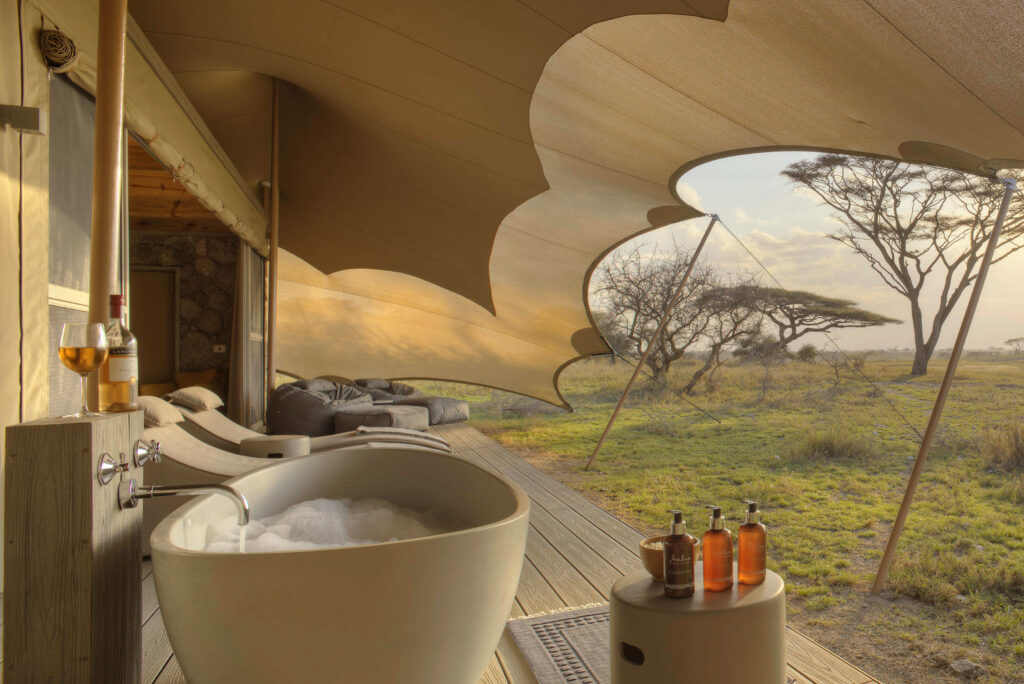
A walk on the wild side is redefined on Asilia’s nine-day walking safari-fly camping adventure. Hiking nine to 15 miles each day, you’ll travel overland from the Ngorongoro Crater, through the Ngorongoro Highlands and into the heart of the eastern Serengeti. You’ll follow in the footsteps of Maasai cattle herders, deep into seldom-visited pockets of the park. Each night you’ll dine and slumber in a lightweight fly camp, fully assembled ahead of your arrival. (The camp is transported by donkeys on night one!) Expedition highlights include the iconic Ngorongoro Crater, the vast and unspoiled Salei Plains (look for gazelle, bat-eared fox, jackal and warthog), sighting Ol Doinyo Lengai and Pride Rock, and passing through Olkerien Gorge. The trek finishes at the barefoot-luxurious Namiri Plains Camp, located on a rugged, wind-whipped plain that had been closed off to tourism for two decades for a big cat study. The result: unspoiled wilderness favored by cheetahs and amenable to bush walks.
This Asilia walking itinerary is seasonal, running from December through March (excluding the Christmas holidays) and has a minimum age requirement of 16.
Camp-to-Camp Walking Safari Transfer: Ngorongoro Crater to the Serengeti
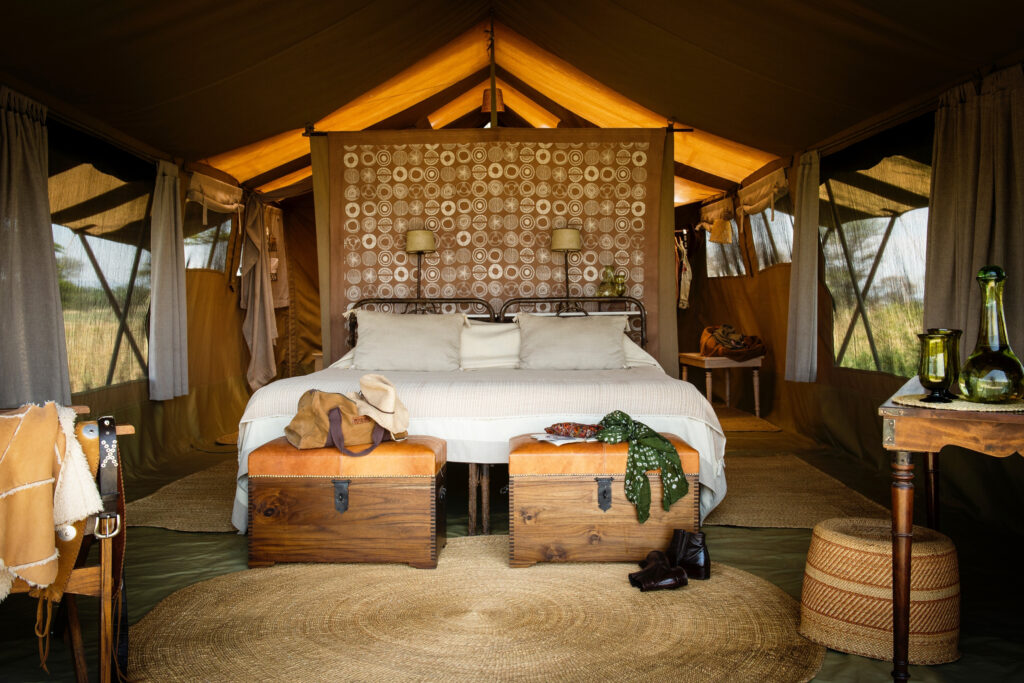
If expedition fly camping sounds too committed, taste a sampler on this eight-day Walks, Wildebeest, and Wild Flowers itinerary which involves a camp-to-camp walking safari component that traverses similar environs. Spend the first two nights at Entamanu Ngorongoro before departing for the Serengeti on foot in the company of Maasai guides. (Why drive when you can stroll off the rim onto the plains?) You’ll follow ancient cattle trails, passing Maasai bomas and acacia woodlands. Incredible views of the Serengeti, Olduvai Gorge, and the Gol Mountains reveal themselves as you descend from the highlands, onto the edge of the endless plains. The walk can be as short as an hour or as lengthy as a half-day—you decide. Wherever you stop, a cook-out brunch is served and a support vehicle completes the transfer to Serengeti Safari Camp, a luxurious six-tent, mobile camp that moves a handful of times each year, depending on the movement of the Great Migration. Seated ringside for this grand wildlife spectacle, spend a few days enjoying private or shared game drives. Next, move onward—by air—to Lamai Serengeti for a trio of nights. The Mara River-bisected plains that surround the gorgeous eight-room lodge play host to migrating wildebeest. Bush walks (not always permitted in national parks) are a wonderful way to experience this game-rich sliver of the Serengeti.
BEST WALKING SAFARIS & HIKES IN THE RIFT VALLEY
The Great Rift Valley Trek
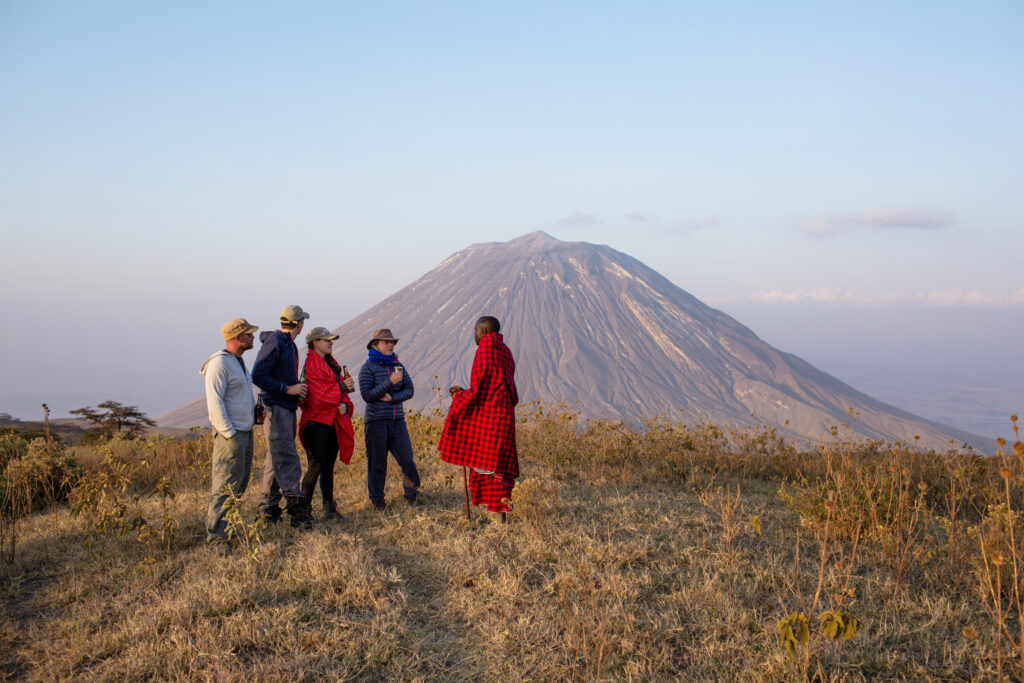
From a crimson lake to caldera peaks, Tanzania’s Great Rift Valley is a landscape sculpted by tectonics. This lesser-visited pocket of the Northern Circuit offers a joyful long-distance walk through the Ngorongoro Highlands alongside Maasai guides.
The Great Rift Valley Trek is a three-night adventure starting at Empakai where you’ll hike to the namesake crater, a collapsed caldera hemmed by a steep, wall of thick forest and partially filled by an alkaline lake. On a clear day, you’ll be able to see Kilimanjaro and Ol Doinyo Lengai. Keep your eyes open for blue monkeys, buffalo, bush bucks and a variety of birdlife. You’ll overnight at Empakai Camp. The next morning, depart with Maasai guides, winding through rolling hills and passing Maasai villages. Sundowners and dinner are served at Leonotis Camp, located snug in a grove of golden acacia trees and miles from anywhere. The next day is the final push, descending seven-and-a-half miles along a breathtaking rift wall, backdropped by the striking presence of Ol Doinyo Lengai. Once you’ve reached the valley floor, you’ll be transferred the rest of the way (approximately eight miles) to your final destination: the 10-tent Lake Natron Camp.
A full day is reserved for Lake Natron, a shallow “soda lake” painted in eye-popping hues of red, orange and pink. Whether you want to relax or adventure is your decision. For a strenuous, 10 to 12-hour excursion, hike to the crater of Ol Doinyo, Tanzania’s only active volcano. For a moderate day hike, venture into nearby Ngare Sero Gorge to cool off in a series of cascading waterfalls. For a gentle amble, take a sunset bird watching walk to view Lake Natron’s charismatic lesser flamingos. Mountain biking, a visit to Ngare Sero Village and some nearby hot springs are also on offer. If you prefer to stick around camp, take a dip in the natural pool next to the mess tent or enjoy a massage before digging into a traditional Maasai BBQ with a chorus of singing.
Ol Doinyo Lengai

Many of northern Tanzania’s natural wonders are volcanic geographic features of the East African Rift. Ol Doinyo Lengai—“Mountain of God” in Maasai language—is no different. For a heart pumping, calf burning, off-the-beaten-path adventure, a hike up this active stratovolcano might be the vertigo-inducing thrill you’re after.
From base-to-crater, Ol Doinyo can be hiked in four to six hours—but this is where the comparison to a “day hike” ends. To avoid the heat of the afternoon, you’ll depart after midnight, meaning, your unrelenting uphill scramble (an elevation gain of 5,288 feet) will start in the dark. The trail is undefined, uneven and sometimes blanketed in loose or compressed ash. You’ll arrive at the crater’s edge for sunrise where a precipitous three- to six-foot lip separates you from the caldera. Peer inside to bear witness to bubbling black lava—a quality found only in this one volcano. Conventional lava is rich in silica, viscous, and boils glowing red at 2,200°F. Conversely, Ol Doinyo’s is “carbonic” (high in calcium, sodium, and potassium), resulting in fast-flowing, cool-boiling lava that closer resembles mud or oil. Uniquely, as it cools, it hardens to white and beige.
Once you’ve earned your views, enjoy them—they are dizzyingly beautiful. Admire the symmetry of the crater, the dramatic rise of the adjacent Rift escarpment and the ridges that spread like veins across the valley floor. When it’s time to leave, steel your nerves to navigate the steep descent that will demand your full attention. Don’t be surprised if you’re reduced to all fours (or even scooting on your bum) to negotiate the incline.
Ol Doinyo Lengai should only be attempted by very fit, experienced hikers. It can not be attempted solo; don’t worry—we’ll hook you up with the best guide. If you are afraid of heights, give Ol Doinyo a pass.
MOUNT KILIMANJARO
Mount Kilimanjaro
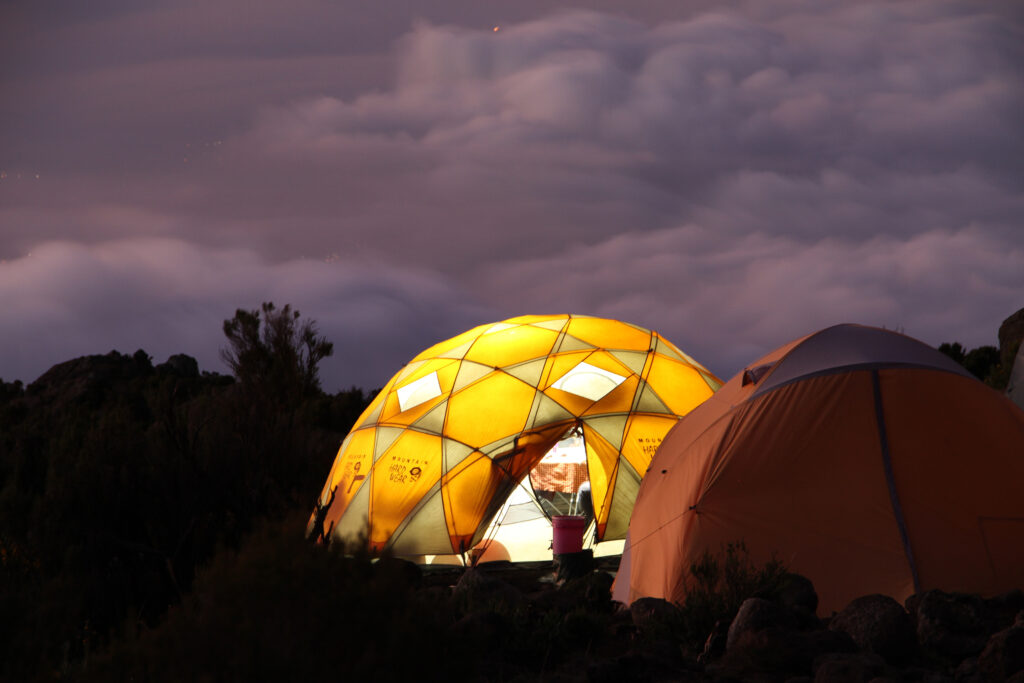
Of course, this list would not be complete without including Mount Kilimanjaro—Tanzania’s longest walk. A sentinel snow-capped peak standing 16,100 feet above the open savannah, the imposing stratovolcano calls to hikers. Tens of thousands of summit-seekers lace up their hiking boots each year; about half succeed.
The ascent to reach the ‘Roof of Africa’ is a story that can be written many ways. There are multiple routes with varying rewards and demands. It can take the form of a six-day sprint or a 10-day trek. Some routes are out-and-back, others follow one route and descend another. What underpins everyone’s ascent are the rigors of altitude. As with most summit attempts, the more time you spend on the mountain, the easier it is to acclimatize—bettering the odds of success.
Extraordinary Journeys Africa specialists’ favorite route is an eight-day Lemosho trek. With a few more days to acclimate, you’re more likely to summit along this west-to-east route that crosses the entire Shira Plateau. Foot traffic is lower (until it joins the Machame Route) and it is considered the most scenic choice. Adding an extra night at Crater Camp means hikers can summit during daylight, rather than the conventional midnight push. We also like the 7-day Macheme trek (Kilimanjaro’s most popular route) for a hardy challenge tempered with great scenery and an ascent profile that’s favorable for acclimatization and summit success. The nighttime ascent of Uhuru Peak is via Stella Point and the descent downloads along the Mweka Route. For intrepid hikers craving solitude, we recommend the lesser-frequented 7-day Rongai trek. Departing from the north side of Kili means the scenery is less varied, but the grade is more forgiving.
BEST WALKING SAFARI IN SOUTHERN TANZANIA
Sand Rivers Fly Camp, Nyerere National Park
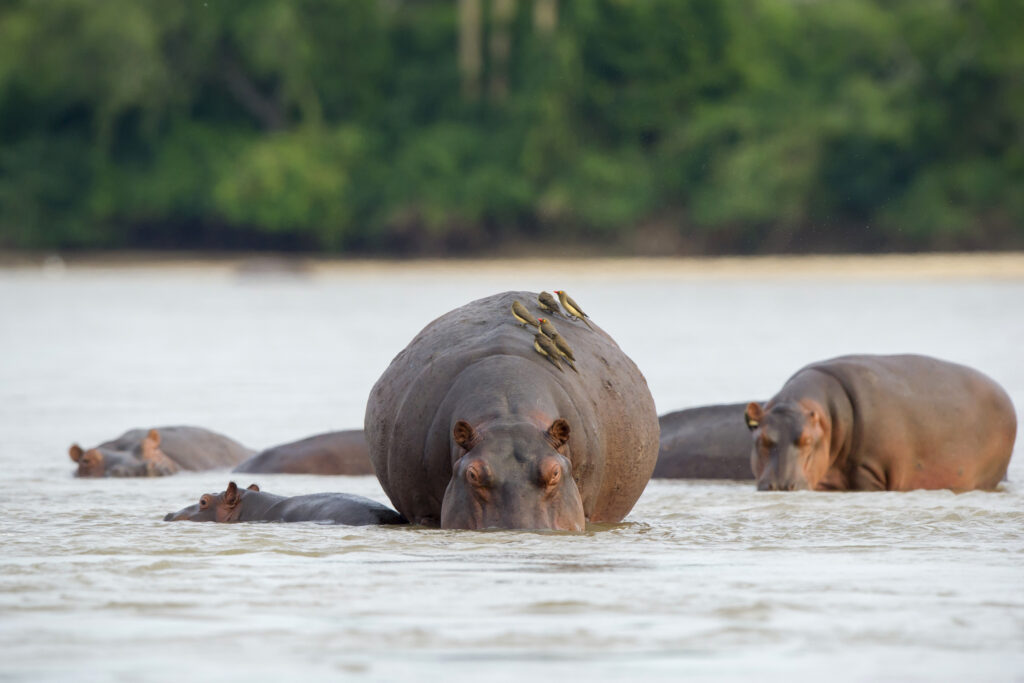
There’s remote…and then there’s Nyere National Park. Hundreds of miles from Tanzania’s headliners (the Serengeti, Kilimanjaro and the Ngorongoro Crater), the uncrowded Southern Circuit beckons to intrepid travelers curious enough to heed its call. To arrive at Sand Rivers Selous lodge, it’s wheels down on a small air strip and then a game drive ground transfer. Now imagine—already miles from anywhere—you venture a few hours further into the bush, on foot, to arrive at the secretive location of your fly camp. Swathed in wilderness, your primordial senses pique. A feeling of vulnerability is balanced by a genuine sense of adventure. On the way in, you’re apt to spot buffalo, giraffe, hippo, lion and zebra. Upon arrival, you’re welcomed into a fully assembled camp, likely next to a sandy riverbank where hippos snort and monkeys rattle in the canopy. The table is set, apéritifs are served and the smell of baking bread wafts on a breeze. Once satiated, post up around the crackling campfire, trading stories with your hosts under a blinking night sky. Tucking into your bedroll, it’s just the “walls” of your mozi-net tent that separate you from the chorus of nocturnal bush calls—but you’ll feel cozy and secure, nonetheless. Most guests spend one or two nights at Sand Rivers Fly Camp, but the add-on is private, so feel free to author your own experience.
